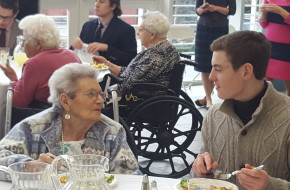It is hard for me to remember a time that I didn’t love art.
In fact, I have been pencil sketching since I was a kid. Ironically enough, I used to draw pictures of airplanes. Little did I know that after college graduation, I would become a pilot—a profession that would take my sketching skills to new heights.
I flew for Pan American Airways. Traveling internationally for a living, I never left home without my sketchpad. It was my companion during layovers. Together, we ventured to some of the most stunning cities around the world. Sketching primarily with charcoal pencils, I captured the beauty of churches in Frankfort, the Opera House in Vienna, Ireland landscapes and street scenes in Warsaw, Africa and Tokyo.
It wasn’t until the mid-1970s that my love for drawing shifted from pencils to watercolor. My wife, Joy, gave me a watercolor kit. For a while, I just dabbled with it, but then I got serious. I took a couple night classes at a local high school to learn water color techniques. I had tried oil painting and acrylics, but I didn’t find them to be as challenging or have the beauty of watercolor.
Water color is more spontaneous—it has a mind of its own. When you put brush to paper, the color spreads and you never know exactly what you will end up with until the color blends.
For more complex pieces of work, I sometimes include color pencils in the process. Not only are they easy to carry around, but they allow you to add more detail to your painting. Using both colored pencils and water color can help an artist cover a larger surface area, create a more interesting background and develop a more involved painting.
Just as my techniques have changed over time, so have my subjects. There was a period when I drew only sailing ships. Then I went back to airplanes.
However, for the last 20 years, I have primarily focused on landscapes. A recent subject has been Cumberland Crossings’ barn. To me it is a magnetic landmark. [As a resident of Cumberland Crossings,] I walk about the campus property three or four times a week, and often wind up at the barn doing some sort of sketch.
I have done many sketches in various seasons. My most favorite painting of the barn—a summer/spring scene that I did three years ago, I donated it to the campus auction benefiting Cumberland Crossings’ fund. Several residents got together and bid more than $400 for the painting, with the executive director agreeing to hang it in the Davis Dining Room.
Of all the sketches and paintings I have done, that is probably the most special. It makes me feel good when I go to dinner and see my painting. More importantly, I enjoy the fact that it was liked enough to be placed where it could be shared with others.
Last year, I did a small watercolor winter scene of the barn. I printed 100 of them on Christmas cards that were sold in the gift shop to benefit the auxiliary. This year, I had another 100 printed. It was then that Diakon hosted a Christmas card art contest for residents. It turns out I won. It was quite an honor.
Anytime I can share my art with others is a pleasure. Over the years, I have started to sell my paintings and show them at local art shows—including at the Waynesboro and Mechanicsburg Art Centers.
My children and grandchildren have their walls lined with things that I have painted—a bottle nose dolphin, a church in Cumberland, Maryland, and airplanes to name a few. I was recently asked how many pieces of art I have produced. I am really not sure. I have three or four sketch books and completed more than 80 paintings. Some are simplistic—others are more detailed.
I work under Parkinson’s Law—the adage that “work expands as to fill the available time for its completion.” However, normally I sit for about an hour at a time to paint. It is therapeutic and relaxing. It is something you can do to allow your mind to be carried away from personal problems. It is an escape. It definitely keeps me going and gives me a reason to get up in the morning.
—Dale Fernandes, 85
Because we review comments, they do not appear immediately. Please do not submit each comment more than once. Please review our comment policy.












